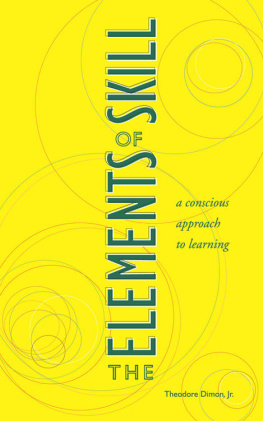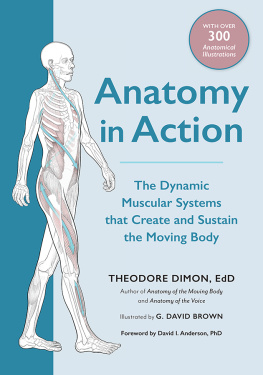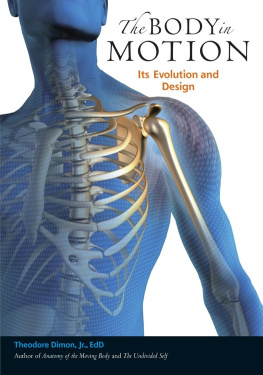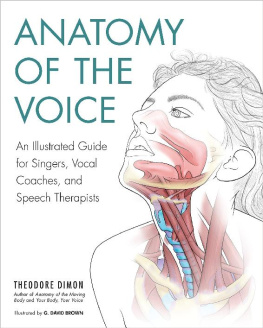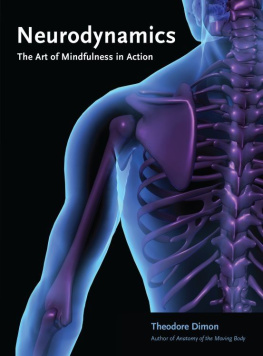
Your Body, Your Voice
Other books by Theodore Dimon
The Elements of Skill: A Conscious Approach to Learning
The Undivided Self: Alexander Technique and the Control of Stress
Anatomy of the Moving Body: A Basic Course in Bones, Muscles, and Joints, Second Edition
The Body in Motion: Its Evolution and Design
Your Body, Your Voice
The Key to Natural Singing and Speaking
Theodore Dimon, EdD
Illustrated by G. David Brown

North Atlantic Books
Berkeley, California
Copyright 2011 by Theodore Dimon. All rights reserved. No portion of this book, except for brief review, may be reproduced, stored in a retrieval system, or transmitted in any form or by any meanselectronic, mechanical, photocopying, recording, or otherwisewithout the written permission of the publisher. For information contact North Atlantic Books.
Published by
North Atlantic Books
Berkeley, California
Cover art iStockphoto.com/RTimages
Cover and book design by Brad Greene
Illustrations G. David Brown
Your Body, Your Voice: The Key to Natural Singing and Speaking is sponsored and published by the Society for the Study of Native Arts and Sciences (dba North Atlantic Books), an educational nonprofit based in Berkeley, California, that collaborates with partners to develop cross-cultural perspectives, nurture holistic views of art, science, the humanities, and healing, and seed personal and global transformation by publishing work on the relationship of body, spirit, and nature.
North Atlantic Books publications are available through most bookstores. For further information, visit our website at www.northatlanticbooks.com or call 800-733-3000.
Library of Congress Cataloging-in-Publication Data
Dimon, Theodore.
Your body, your voice: the key to natural singing and speaking / Theodore Dimon Jr.
p.; cm.
Includes bibliographical references.
Summary: Your Body, Your Voice presents the basic underlying design principles of the human voice, addresses harmful patterns of speech and singing, and offers techniques designed to restore the voice to its full potentialProvided by publisher.
ISBN 978-1-58394-320-5
ISBN 978-1-62317-789-8 (e-book)
1. VoicePhysiological aspects. 2. Breathing exercises. 3. Larynx. 4. Voice culture. I. Title.
[DNLM: 1. Voicephysiology. 2. Breathing Exercises. 3. Larynxphysiology. 4. Respiration. 5. Voice Training. WV 501]
QP306.D56 2011
612.78dc22 2010051132
Acknowledgments
There are a number of people who have helped, directly and indirectly, in the making of this book. First I would like to thank Seymour Simmons, my friend and colleague, for his constant support and advice. Thanks also to Dena Davis, who has supported my career practically from the beginning.
I would like to thank Richard Grossinger and North Atlantic Books; Jessica Sevey, editor at North Atlantic Books; Brad Greene for his excellent cover design; and Judy Gitenstein, editor and publishing consultant, for her advice and support.
I would like to thank Professor Vernon Howard, my advisor while I was a graduate student at the Harvard Graduate School of Education, for giving me the freedom to pursue my interest in this subjectthe beginning of a long and fascinating inquiry into the workings of the human voice.
I would like to thank Jean Clark, my friend, colleague, and teacher, who has so generously helped me over the years to understand different aspects of the voice and the related subject of bodily coordination.
Thanks to Dan Marcus, my friend and colleague, for his invaluable input on the manuscript, and for the wonderful help and support he has given me as a friend and colleague.
Thanks also to Serena Woolf, my agent and personal assistant, who has helped with several aspects of this manuscript.
I would like to thank David Brown for his superb illustrations.
Finally, I want to thank Walter Carrington, whose insights into this subject gave me the initial inspiration for many of the ideas expressed in this book.
Contents
1. The Organizing Principle of the Voice
2. Breathing
3. The Larynx
4. The Suspensory Muscles of the Larynx
5. The Problem of Support
6. Vocal Registers
7. The Singers Throat
8. Placement
9. Preventing the Basic Pattern of Vocal Misuse
12. Producing a Pure Sung Tone
This book describes how the voice can work naturally and effortlessly when we understand how it is designed to work as a complete system. It explains not only how to improve specific vocal functions but also shows how these functions are dependent on the working of the body as a whole. When this larger system works efficiently, the voice is able to function with effortless ease simply by being used according to its natural design. Understanding this holistic design elucidates in a new way how the voice works. It also shows why the most fundamental knowledge the singer or actor needs to possess about the voice is not how to train it, but how it works as a total dynamic system.
This book has been over thirty years in the making and during that time has gone through various stages of development. As a young man I took up singing and guitar, performing sporadically. Over the years I became increasingly interested in the voice and studied vocal technique. In my first year of graduate school I wrote a paper on breathing and its relation to vocalizationa topic that I continued to explore with further papers explaining the importance of controlled exhalation in producing effortless vocal support. These papers provided a foundation for some basic ideas on vocal production and pedagogy. However, in order to communicate the more subtle and complex concepts that underlay a complete treatise on the voice, a larger framework was required to describe how the voice works as a functional system. To this end I spent over a year researching various aspects of the voice and then, in a series of short papers, described each vocal system and how it worked individually; this also provided the key for expressing how they worked together as a functional whole. This body of work made it possible to develop a complete volume on the subject, which includes essential components that have been omitted from other literature on the voice.
The reader may notice that, although the book does contain some anatomical details (as well as quite a few anatomical drawings), I have nevertheless kept anatomical descriptions to a minimum. The reason for this is that I wanted to keep the book as simple as possible and not burden the reader with technical details that obscure the main arguments. At the same time, I became acutely aware, during my own research, of the lack of a unified source of anatomical knowledge on the voice, and wanted to provide such a reference for readers interested in gaining a detailed knowledge of the voice. This book is therefore the first of two volumes; the second book, titled Anatomy of the Voice, will describe the larynx and other vocal systems in greater detail and will be published in the future.
The human voiceas anyone who has studied it knowsis a remarkably complex instrument. The lungs and rib cage, the intricate musculature of the larynx, the network of throat muscles that act on the larynx and form the resonator of the throatall these structures cooperate in the most subtle and marvelous ways to produce sound, and enable us to vary these sounds in an infinite variety of ways.
Next page

